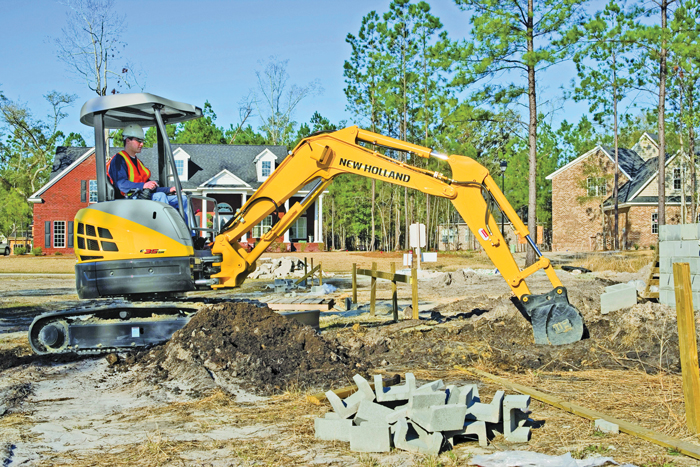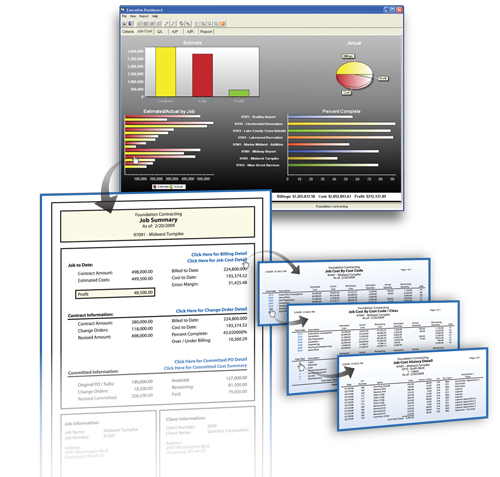Job Costing Equipment with Software
 Buying a shiny new piece of equipment can be a thrill for a contractor. But as soon as it’s purchased, the value begins depreciating, and once that piece of equipment is being used, one big question arises — “Am I getting my money’s worth?” Knowing the answer to this question is more than a luxury for contractors who own equipment — it’s a necessity to ensure that their jobs remain profitable. So how can they figure it out?
Buying a shiny new piece of equipment can be a thrill for a contractor. But as soon as it’s purchased, the value begins depreciating, and once that piece of equipment is being used, one big question arises — “Am I getting my money’s worth?” Knowing the answer to this question is more than a luxury for contractors who own equipment — it’s a necessity to ensure that their jobs remain profitable. So how can they figure it out?
The only true way is to compare the money spent on repairs and maintenance against how much the equipment is actually used. One way this can be done is by using construction accounting software to cost equipment to each job on which it’s used. This will help contractors measure the ROI of equipment on the jobsite by giving them a truer picture of total costs on a job and helping them monitor the efficiency of their equipment.

A True Picture of Total Costs on a Job
For contractors to truly see what a job is costing them, they must include all of the elements of the job — including the cost of using the equipment they own. Unfortunately, many contractors just don’t do this. Some say that establishing a pricing structure can be difficult with ownership and operating costs, while others struggle with how to collect equipment usage data from the field and convert it into useful data. Or, they may simply overlook owned equipment as a cost.
Contractors must remember, however, that even though they own a piece of equipment, it still accrues cost through general use, upkeep (maintenance and repairs) and depreciation. That’s why it’s critical to include this cost right at the beginning of the estimating stage and make sure it flows over the life cycle of the job. This will allow contractors to view an accurate comparison of the estimated vs. actual costs of using the equipment, bringing about two major advantages:
1) Better Job Cost Data During the Life Cycle of a Job
As mentioned above, including equipment costs during the estimating phase and tracking these costs throughout the job will give contractors better work-in-progress reporting. Contractors can see what costs are incurred to date, which helps them stay on track with the estimated cost. Tracking equipment costs also gives contractors the luxury of being able to make adjustments during the life cycle of a job should they encounter a problem. Overall, this provides better job management and more complete data.
2) Better Data for More Effective Future Bidding
Costing equipment on a job will also give contractors a better idea of how much it actually costs them to use certain machines. They can then utilize this data for better bidding and estimating on future projects.
Gaining a clearer picture of costs on a job by costing equipment not only gives contractors the ability to make adjustments to a job on the fly, but also provides them with the tools to become more competitive with their bidding from the start. These two benefits alone can ultimately help them win more jobs.

Whether contractors own one piece of equipment or many, there are a variety of factors that can affect their efficiency — the operator, weather conditions, equipment age, maintenance and more. Job costing gives contractors access to valuable information that will allow them to determine how efficient their equipment is based on these factors, and whether it’s making or losing money. This is done by using job costing to compare the usage of the equipment against the cost of using it.
One way to get this information is with the help of good construction-specific accounting software. Usually, there is an area in the program dedicated to equipment, where contractors can log job cost data and view reports like usage vs. cost. On the surface, this report will allow contractors to compare their estimated cost vs. their actual cost on their machines by hour, day, week or even month. Depending on the accounting program, it may also permit for detailed drill down into both usage and cost, which will allow contractors to see the following:
Usage
Job costing equipment gives contractors access to usage reporting, which creates the ability to see what job a piece of equipment was used on, how many hours it was used and by whom. This gives great insight as to how efficient one operator is compared to another, so project managers can make the most of their resources. It also shows how long it takes a certain piece of equipment to complete a task. If the task is taking longer to complete than it should, that piece of equipment may need to be re-evaluated.
Cost
Contractors can also track actual costs recorded (labor, overhead, maintenance, burden, materials, insurance, depreciation, fuel, licenses, etc.) by assigning specific codes to each type of cost. At the base level, most contractors will have at least three different codes for maintenance, repair and overhead. They can then use this information to determine how much they should be charging per hour on a job, which leads to better bidding.
Looking at the usage versus the cost will also give contractors the ability to make important decisions about the equipment they maintain. For example, if a company is spending more money on frequent repairs and maintenance of a work truck, that piece of equipment may be costing them more than it’s making them. Therefore, it might be time to evaluate whether the equipment can handle the workload. If not, it needs to be replaced, or the contractor can choose to limit it to smaller tasks. Or, if the piece of equipment isn’t being fully utilized, it may make more sense to rent that piece of equipment as needed instead of owning it. Making these decisions early on can save contractors big money in the long run.
The Decision to Job Cost Equipment
Specialized machines and vehicles truly help fuel equipment-intensive contractors’ success, but only if they know their actual equipment costs and make the effort to track their equipment usage. Costing equipment over time will offer both short-term and long-term benefits. And there are tools available to help simplify the process, like construction-specific accounting software that can automate the tracking of costs and usage. Ultimately, contractors who cost their equipment will gain knowledge about how to better manage their jobs, increase efficiency and get their money’s worth on their investments.
Fred Ode is the CEO and chairman of Foundation Software, based in Strongsville, Ohio.
